When it comes to processing fruit, following proper storage and ripening guidelines is essential. Not only does this ensure the best taste and freshness, but it also helps in preserving the nutritional value of the fruit. Whether you are a novice or an experienced fruit processor, understanding the step-by-step methods, preservation techniques, and equipment needed is key to achieving outstanding results.
In this article, I will guide you through the process of fruit preparation and share valuable insights into the fruit processing industry, technology, recipes, and the many benefits it offers.
Key Takeaways:
- Proper storage and ripening guidelines are crucial for effective fruit processing.
- Each fruit has specific requirements for storage and ripening.
- Accelerate the ripening process using methods like the paper bag technique or adding an apple or banana.
- Learn how to store different fruits like apples, avocados, bananas, berries, citrus fruits, mangoes, melons, pears, and more.
- Understanding proper fruit storage techniques maximizes freshness and minimizes wastage.
Storage and Ripening Guidelines for Different Fruits
Proper storage and ripening are essential when it comes to processing fruits. Each fruit has specific guidelines to ensure that it stays fresh and maintains optimal flavor. Let’s explore some best practices for storing and ripening different types of fruits:
Apples
Apples should be stored in a cool place, away from direct sunlight and heat. Refrigeration is recommended for longer storage. Here are the key guidelines:
- Store apples in a cool space, ideally between 32°F and 40°F (0°C and 4°C).
- Avoid storing apples with other fruits, as they release ethylene gas that can accelerate ripening.
- Use airtight containers or plastic bags with small holes to maintain freshness.
Apricots, Apriums, and Plums
These fruits continue to ripen after picking and should be stored at room temperature until they are soft and aromatic. Consider these tips:
- Store them at room temperature, preferably between 50°F and 68°F (10°C and 20°C).
- Keep them away from direct sunlight, as it may cause them to overripen.
Avocados
Avocados should be stored at room temperature until they are ripe, and then refrigerated for several days. Follow these guidelines:
- Store unripe avocados at room temperature until they give slightly to pressure.
- Once ripe, you can refrigerate avocados for further storage, but they may lose some flavor and texture.
- For optimal ripening, place avocados in a brown paper bag with a banana or apple, as they release ethylene gas that speeds up the process.
Using the right containers for fruit storage can help extend their shelf life. Here are some options:
| Container Type | Best Suited for |
|---|---|
| Refrigerator Crisper Drawers | Apples, berries, citrus fruits |
| Mason Jars or Glass Containers | Cut fruits, such as melons and pineapples |
| Vented Plastic Bags | Grapes, cherries, and other small fruits |
By following these storage and ripening guidelines, you can ensure that your fruits stay fresh and flavorful. Understanding the specific needs of each fruit will help you process them effectively and make the most of their natural goodness.
Tips for Ripening Fruit Faster
If you have unripe fruit and want to accelerate the ripening process, there are a few methods you can try. One classic technique is the paper bag method. Simply place the fruit in a paper bag and seal it to trap ethylene gas, a natural plant hormone that speeds up ripening. Adding an apple or banana to the bag can further enhance the process, as they produce higher levels of ethylene gas.
There are also other fruit ripening methods you can experiment with. For avocados, try the flour in a bag method. Put the unripe avocado in a bag with a spoonful of flour to enhance ethylene concentration. If you have mangos, the rice in a bowl method can be effective. Place the mango in a bowl with rice to absorb excess moisture and regulate ethylene distribution. Lastly, for peaches, the linen cloth method can help achieve faster ripening. Wrap the unripe peach in a linen cloth to control moisture levels and encourage proper ripening.
By following these fruit ripening tips, you can enjoy fully ripe fruit in a shorter amount of time. It’s worth noting that not all types of fruit respond the same way to these methods, so it’s a good idea to experiment and see which techniques work best for the specific fruit you’re ripening.
How to Store Apples for Extended Shelf Life
When it comes to storing apples for an extended period, following the right guidelines is essential. Proper storage conditions play a crucial role in maintaining their freshness and maximizing their shelf life. Here, I will share some expert tips on storing apples effectively.
1. Choose the Right Space
Apples should be stored in a cool space away from direct sunlight and heat. This helps to prevent premature ripening and maintain their quality. A pantry or cellar is an ideal location for storing apples.
2. Refrigerate for Extended Storage
If you want to extend the shelf life of your apples, refrigeration is the key. Apples can stay fresh in the refrigerator for up to 3-4 weeks. However, it’s important to store them properly to prevent moisture loss and maintain their crispness.
Proper apple storage is crucial for maintaining their freshness and maximizing their shelf life. By following these simple guidelines, you can enjoy apples at their best for an extended period.
3. Use a Bag with Holes
When storing apples in the refrigerator, it’s recommended to use a bag with holes or a perforated plastic bag. This allows for proper air circulation, preventing moisture buildup and maintaining the apples’ texture.
4. Separate from Other Fruits and Vegetables
Apples release ethylene gas, which can speed up the ripening process of other nearby produce. To prevent this, store apples separately from other fruits and vegetables. This will help maintain their freshness and prevent premature spoilage of other items in your produce drawer.
5. Understand the Ripening Process
Apples have a unique ripening process that varies among different varieties. Some apples, like Granny Smith and Fuji, are harvested when they are already mature, while others, like Golden Delicious and Red Delicious, continue to ripen after picking. Understanding the ripening process of the specific apple variety you have will help you determine the optimal time for consumption.
6. Keep an Eye on Damaged Apples
It’s important to regularly check your stored apples and remove any that show signs of damage or decay. Damaged apples can accelerate the ripening process of other apples and cause spoilage.
In conclusion, proper storage is key to keeping apples fresh for a longer period. By storing them in a cool place, refrigerating them when necessary, using a bag with holes, separating them from other produce, and staying vigilant about damaged apples, you can enjoy the crispness and flavors of apples for weeks on end.
How to Store Avocados for Optimal Freshness
When it comes to storing avocados, following the right guidelines is crucial to maintain their freshness and enjoy them at their best. Here are some tips to help you preserve avocados:
- Store at room temperature: Avocados should be stored at room temperature until they are ripe and yield slightly to pressure when gently squeezed. Placing them in a bowl or basket on the kitchen counter ensures proper air circulation and natural ripening.
- Refrigerate when ripe: Once avocados reach their desired ripeness, they can be refrigerated to prolong their shelf life. This is especially useful if you have ripe avocados that you won’t be able to consume immediately. Store them in the refrigerator for up to a few days.
- Prevent browning: To prevent cut avocados from browning, you can either store them in an airtight container with the pit intact or apply a squeeze of lemon or lime juice on the exposed flesh. Both methods help minimize oxidation and keep the avocado flesh fresh and green.
- Consider using an avocado saver: An avocado saver is a handy tool designed to keep cut avocados fresh for longer. It creates a tight seal around the exposed flesh, preventing air exposure and slowing down the oxidation process.
By following these avocado storage guidelines, you can ensure that your avocados stay fresh and delicious until you’re ready to enjoy them.
Avo-Tip:
Placing an onion or tomato slice on top of cut avocados can also help prevent browning by creating a physical barrier between the avocado flesh and the air.
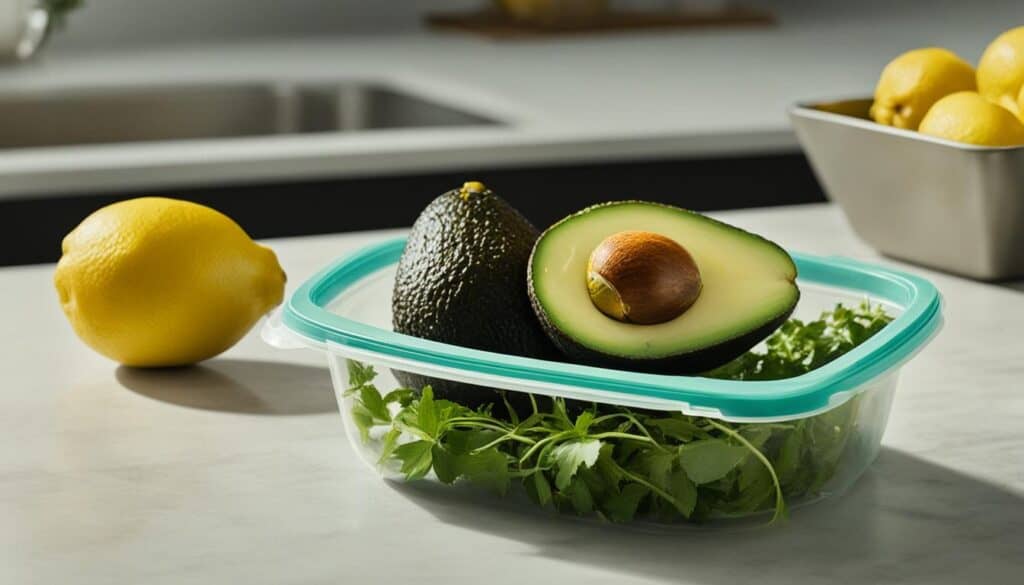
Avocados are a versatile and nutritious fruit, and proper storage ensures that you can savor their creamy goodness whenever you desire. So, make sure to store your avocados following these guidelines to maintain their optimal freshness.
How to Store Bananas to Extend Their Shelf Life
Bananas are a delicious and nutritious fruit that can be enjoyed in many ways. To ensure they stay fresh for longer and prevent spoilage, it’s important to follow proper banana storage guidelines.
First and foremost, bananas should be stored at room temperature, away from direct sunlight and heat sources. This helps to slow down the ripening process and prevents them from becoming overripe too quickly.
If you want to speed up the ripening process of bananas, you can use a simple trick. Place them in a paper bag with an apple overnight. The ethylene gas released by the apple will help to ripen the bananas faster.
Once the bananas are ripe, you have the option to refrigerate them to extend their shelf life. However, it’s important to note that refrigerated bananas may develop black skins. Don’t worry, though! The flesh inside will continue to ripen and can still be consumed.
Alternatively, if you have overripe bananas that you can’t consume in time, you can freeze them for later use. Peel the bananas and place them in an airtight container or freezer bag. Frozen bananas are perfect for making smoothies or baking delicious treats.
By following these banana storage techniques, you can enjoy bananas at their best and reduce wastage. Take a look at the table below for a quick summary of the recommended storage guidelines:
| Storage Method | Temperature | Ripening Process | Shelf Life |
|---|---|---|---|
| Room Temperature | Away from direct sunlight and heat | Slower ripening | Shorter |
| Refrigeration | Below 50°F (10°C) | Slower ripening, black skin possible (flesh still ripens inside) | Extended |
| Freezing | Below 0°F (-18°C) | N/A (already ripe) | Up to 6 months |
Remember, proper banana storage is essential for maintaining their freshness and flavor. Whether you prefer them ripe or slightly green, handling and storing bananas correctly will ensure that you always have a delicious and versatile fruit on hand.
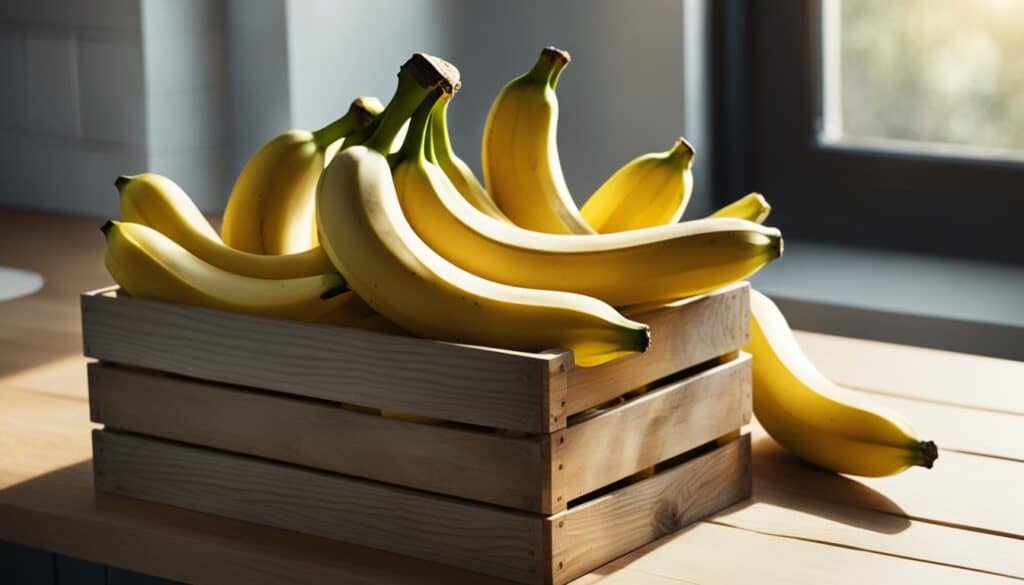
How to Store Berries for Maximum Freshness
Berries are a delightful and nutritious addition to any diet, but their delicate nature requires proper storage to maintain their freshness. By following these guidelines, you can ensure that your berries stay flavorful and delicious for longer periods.
1. Avoid Washing Berries Until Ready to Consume
One of the key tips for storing berries is to refrain from washing them until you’re ready to eat or use them. Washing berries prematurely can introduce moisture, which can lead to mold growth and spoilage. Instead, store your berries unwashed to preserve their quality.
2. Keep Berries Refrigerated
Berries should be stored in the refrigerator to maintain their freshness. The cool temperature helps slow down the ripening process and extends the shelf life of the berries. Ideally, store them in the original packaging or in a breathable container to provide adequate air circulation.
3. Only Remove What You Will Eat
To prevent unnecessary exposure to air and moisture, only remove the amount of berries you plan to eat. This practice helps preserve the remaining berries, ensuring they stay fresh and flavorful for future consumption.
4. Freezing Berries for Longer Storage
If you have an abundance of berries or want to preserve them for future use, freezing is an excellent option. Before freezing, make sure to remove any stems or hulls and gently pat the berries dry to remove excess moisture. Then, place the berries in airtight containers or freezer bags to prevent freezer burn and maintain their quality. Label the containers with the date for easy identification.
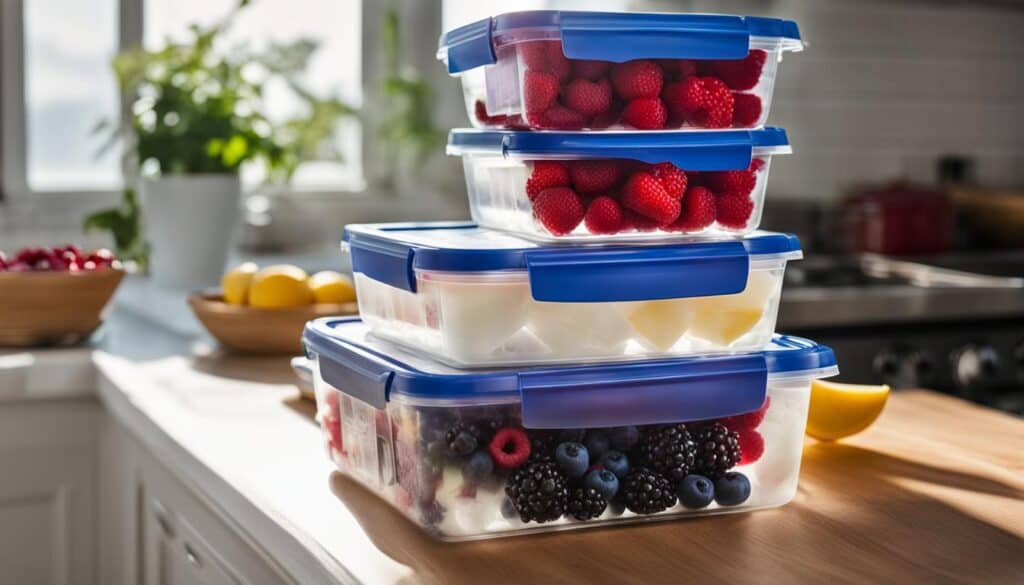
5. Thawing Frozen Berries
When you’re ready to use your frozen berries, it’s essential to thaw them properly. Avoid thawing at room temperature, as this can lead to a loss of texture and flavor. Instead, thaw the berries in the refrigerator overnight or use the defrost setting on your microwave for quick thawing.
Incorporate these guidelines into your berry storage routine to enjoy fresh and delicious berries for an extended period. Whether you’re adding them to smoothies, desserts, or enjoying them on their own, properly stored berries will enhance your culinary creations and provide a burst of summer flavor year-round. Remember, with the right storage techniques, you can indulge in the goodness of berries whenever your heart desires.
How to Store Citrus Fruits for Prolonged Freshness
When it comes to storing citrus fruits like lemons, limes, grapefruits, and oranges, it’s important to follow proper storage guidelines to ensure their prolonged freshness. With the right techniques, you can maximize the shelf life of these vibrant and vitamin-packed fruits.
To store citrus fruits effectively, it’s best to keep them in a cool space, preferably in the crisper drawer of your refrigerator. This helps maintain their freshness and prevents them from drying out. However, if you plan to consume oranges or lemons within a week, they can be stored at room temperature.
When storing citrus fruits, using a breathable bag can help maintain their freshness by allowing some air circulation while protecting them from drying out. This is especially important for longer-term storage in the refrigerator.
If you have an abundance of citrus fruits and want to preserve them for an extended period, freezing is an excellent option. Proper peeling and packaging are essential for successful freezing. Start by peeling the fruits and removing any seeds. Then, individually wrap each fruit in plastic wrap or place them in a freezer-safe container. This helps prevent freezer burn and preserves the quality of the fruits.
By following these citrus fruit storage guidelines, you can ensure the longevity of your citrus fruits and have them ready whenever you need to add a burst of refreshing flavor to your dishes or enjoy their tangy goodness as a healthy snack.
| Citrus Fruit | Storage |
|---|---|
| Oranges | Refrigerator or room temperature for up to a week |
| Lemons | Refrigerator or room temperature for up to a week |
| Limes | Refrigerator |
| Grapefruits | Refrigerator |
Store your citrus fruits properly to maximize their shelf life and savor their zesty flavor even longer.
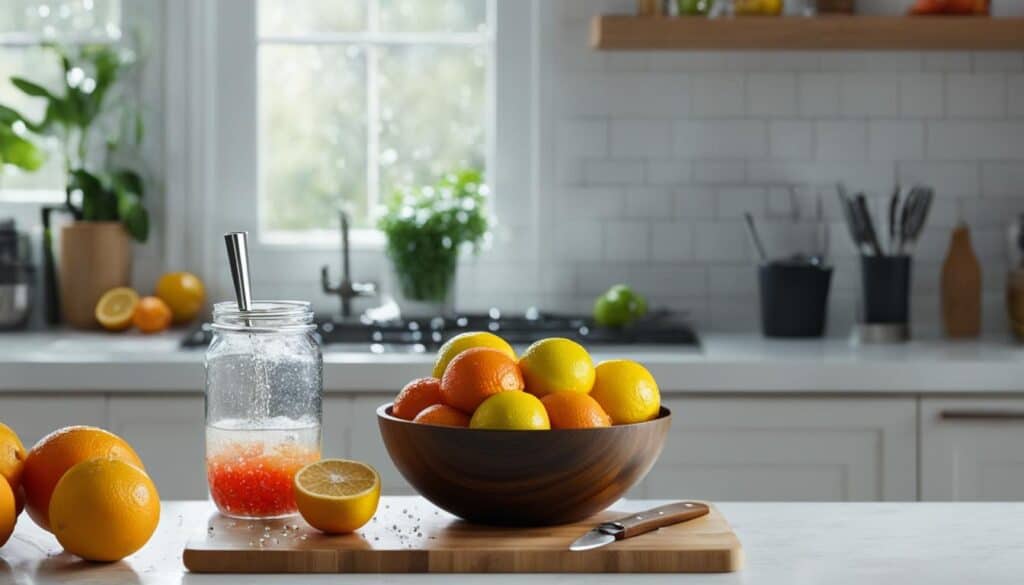
How to Store Mangoes for Extended Enjoyment
Mangoes are a delicious tropical fruit that can be enjoyed in various ways. To ensure their freshness and prolong their shelf life, proper storage techniques are essential. By following these mango storage guidelines, you can savor the sweet and juicy flavors of mangoes for longer periods.
If your mangoes are not yet ripe, store them at room temperature on the counter. Placing them in a bowl or basket will help prevent bruising and maintain their shape. Avoid storing mangoes near other fruits, as they release ethylene gas, which can speed up the ripening process of nearby produce.
Once your mangoes reach the desired ripeness, you can slow down the ripening process by refrigeration. Place the ripe mangoes in a breathable plastic bag or wrap them individually in paper towels to protect them from drying out. Refrigerate the mangoes for up to five days to extend their freshness.
To preserve mangoes for longer periods, consider freezing them. Frozen mangoes are perfect for smoothies, desserts, and other culinary creations. Here’s how you can freeze mangoes:
- Peel and remove the pit from the mangoes.
- Cut the mango flesh into uniform slices or chunks.
- Arrange the mango pieces on a baking sheet lined with parchment paper.
- Place the baking sheet in the freezer and freeze the mangoes until they are firm.
- Transfer the frozen mango pieces into airtight freezer bags or containers.
- Label the bags or containers with the date and store them in the freezer for up to six months.
When you’re ready to use the frozen mangoes, simply thaw them in the refrigerator or use them directly in your recipes. The frozen mangoes may become slightly softer, but their flavor and nutritional value will remain intact.
Remember, mangoes are sensitive to temperature changes and can spoil quickly if not stored properly. Follow these guidelines and enjoy the delightful taste of mangoes all year round.
How to Store Melons for Prolonged Freshness
Melons, including cantaloupes, honeydews, and watermelons, have specific storage requirements to ensure their freshness. Here are some guidelines to help you store melons and keep them at their best for a longer time:
- If the melons are not yet ripe, they should be left on the countertop for a few days to ripen. This allows them to develop their characteristic flavor and sweetness.
- Placing the melons in a paper bag can help speed up the ripening process. The paper bag traps ethylene gas, a natural ripening agent, and helps the fruit ripen faster.
- Once the melons are ripe, they can be refrigerated to extend their shelf life. Store them in the refrigerator at a temperature of around 40°F (4°C).
- Watermelons, however, should be refrigerated immediately after being removed from the vine, as they do not ripen further. Keep them in the refrigerator until ready to consume.
- If you have leftover melons or want to store them for later use, you can cut them into cubes or slices and freeze them. Frozen melons are great for adding to smoothies, sorbets, or fruit salads.
By following these storage guidelines, you can enjoy melons at their best and prolong their freshness. Remember to check the ripeness and refrigerate them when needed. Frozen melons can be a convenient and delicious way to enjoy this refreshing fruit even when it’s out of season.
| Melon Type | Storage Method |
|---|---|
| Cantaloupes | Ripen on the countertop; refrigerate once ripe |
| Honeydews | Ripen on the countertop; refrigerate once ripe |
| Watermelons | Refrigerate immediately after harvest; do not ripen further |
How to Store Pears for Lasting Freshness
Pears have unique storage requirements to maintain their freshness and ripen properly. Here are some guidelines to help you store pears and enjoy them at their best:
Storing Pears at Room Temperature:
To store pears, keep them at room temperature away from heat and sunlight. Place them in a cool, well-ventilated area. Pears should be stored upright, preferably in a fruit bowl or on a countertop. Check the pears daily and gently press near the stem to determine their ripeness. Once the pears give slightly to touch, they are ready to eat.
Refrigerating Ripe Pears:
Once the pears are ripe, you can refrigerate them to prolong their freshness. Place ripe pears in the refrigerator for up to five days. Refrigeration slows down the ripening process and helps maintain the pears’ texture and flavor.
Preserving Pears by Freezing:
If you have an abundance of pears or want to preserve them for later use, freezing is a great option. Follow these steps to freeze pears:
- Peel, core, and slice the pears.
- Spread the pear slices in a single layer on a baking sheet lined with parchment paper.
- Place the baking sheet in the freezer for a few hours or until the pear slices are completely frozen.
- Transfer the frozen pear slices into a freezer-safe bag or container.
- Label the bag or container with the date and store it in the freezer for up to six months.
Frozen pears can be used in various recipes, such as smoothies, pies, or baked goods.
By following these storage techniques, you can enjoy pears at their peak ripeness and flavor, whether it’s by storing them at room temperature, refrigerating ripe pears, or freezing them for later use.
Conclusion
Proper fruit storage and ripening techniques are crucial for processing fruit easily and maintaining its freshness. By understanding the specific storage requirements and ripening processes for different fruits, you can maximize the enjoyment of your fruit and reduce wastage. Remember to store fruit in the appropriate conditions, such as keeping apples refrigerated and avocados at room temperature until ripe. Avoid washing fruit before necessary, as it can lead to moisture seeping in and spoilage. When needed, utilize methods like the paper bag method to accelerate the ripening process.
Proper fruit storage is important not only for preserving freshness but also for safety and taste. By following the guidelines mentioned in this article, you can enjoy the flavors and benefits of fruit for a longer time. Whether you’re a home cook or part of the fruit processing industry, implementing these tips and techniques will help you make the most of your fruit processing endeavors.
Remember, fruit processing is not just about handling the fruit but also about understanding how to maintain its quality. From apples to avocados, berries to melons, pears to citrus fruits, each fruit has its unique storage requirements and ripening processes. By considering the importance of proper fruit storage and following the guidelines provided, you can enjoy fresh and flavorful fruit whenever you desire. So go ahead, process your fruit with confidence, and embrace the benefits of proper fruit processing!
FAQ
How do I process fruit easily?
To process fruit easily, it is important to follow proper storage and ripening guidelines. Understanding the specific storage requirements and ripening processes for different fruits allows for optimal enjoyment and reduced wastage.
What are the storage and ripening guidelines for different fruits?
Different fruits have specific storage and ripening requirements. For example, apples should be kept in a cool space away from sunlight and heat, while avocados should be stored at room temperature until they are ripe and then refrigerated. Understanding these guidelines will help you process fruit effectively.
How can I ripen fruit faster?
To accelerate the ripening process of fruit, you can try methods such as the paper bag method, which involves sealing the fruit in a paper bag to trap ethylene gas and speed up ripening. Adding an apple or banana to the bag can further enhance the process.
How should I store apples for extended shelf life?
Apples should be kept in a cool space away from sunlight and heat. Refrigerating apples can help extend their shelf life up to 3-4 weeks. It’s advisable to store them in a breathable bag with holes in the crisper drawer for maximum freshness.
What are the storage guidelines for avocados?
Avocados should be stored at room temperature until they are ripe and give slightly to pressure. Once ripe, they can be refrigerated for several days. To prevent browning, half-avocados can be stored in an airtight container with the pit still in place.
How can I store bananas to extend their shelf life?
Bananas should be stored at room temperature away from direct sunlight and heat. To speed up the ripening process, bananas can be placed in a paper bag with an apple overnight. Once ripe, bananas can be refrigerated. Overripe bananas can be frozen for future use.
What are the storage guidelines for berries?
Berries should be kept refrigerated and removed only what you will eat. Storing them unwashed helps to preserve their quality. For longer storage, berries can be frozen, ensuring they are stored in airtight containers or freezer bags.
How should I store citrus fruits for prolonged freshness?
Citrus fruits should be kept in a cool space, preferably in the crisper drawer of the refrigerator. Oranges and lemons can also be stored at room temperature for up to a week. It’s advisable to keep them in a breathable bag to maintain freshness.
What are the storage guidelines for mangoes?
If mangoes are not yet ripe, it’s recommended to store them at room temperature on the counter. Once they are ripe, they can be refrigerated for up to five days to slow down the ripening process. Mangoes can also be peeled, cut into pieces, and stored in the freezer for up to six months.
How should I store melons for prolonged freshness?
If the melons are not yet ripe, they should be left on the countertop for a few days to ripen. Once the melons are ripe, they can be refrigerated to extend their shelf life. Watermelons, however, should be refrigerated immediately after being removed from the vine, as they do not ripen further.
What are the storage guidelines for pears?
Pears should be stored at room temperature away from heat and sunlight until they give slightly to touch. Once ripe, pears can be refrigerated for up to five days to slow down the ripening process. Pears can also be frozen by peeling, coring, and slicing them for future use.

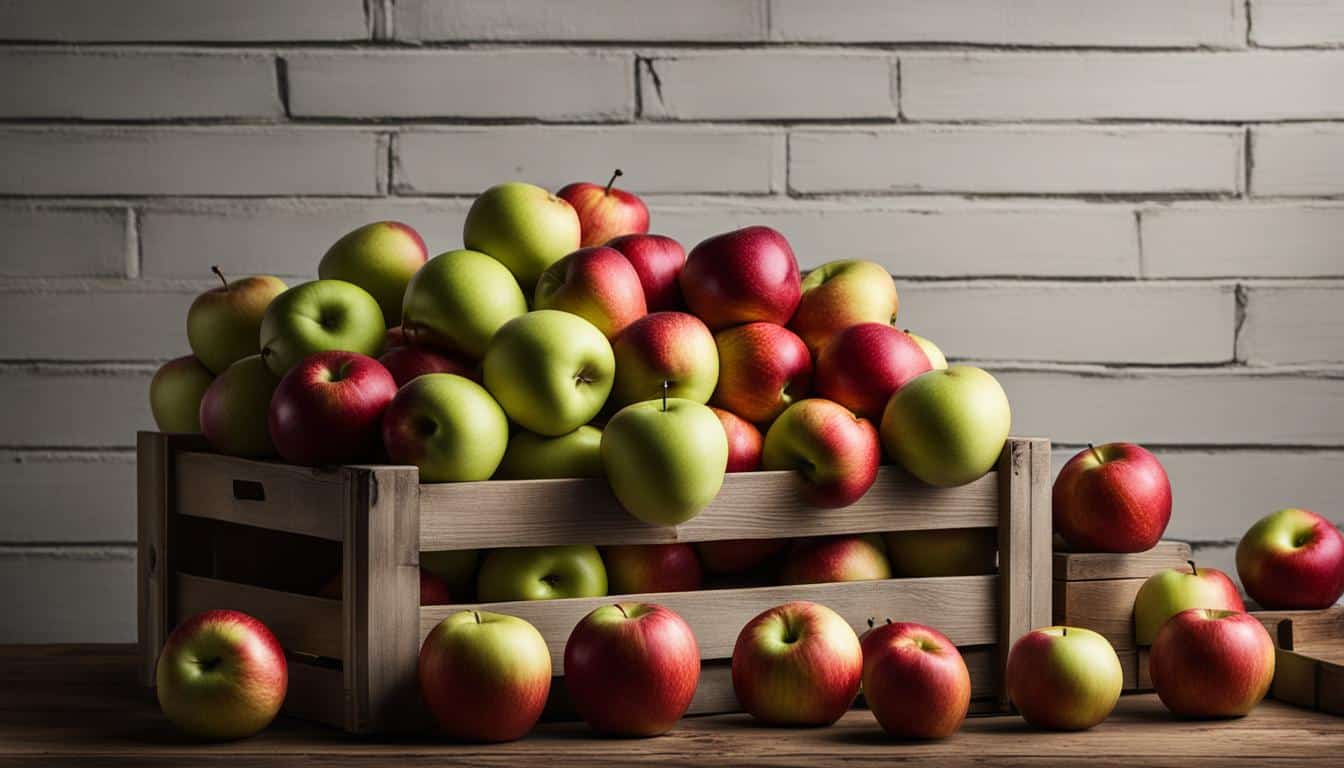



Leave a Reply